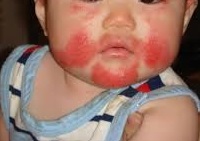First described in 1981, acute kiwifruit allergy has since been documented in several parts of the world, admittedly with increasing frequency.
The first reported case of kiwi fruit allergy was on a 53-year-old woman who developed urticaria, wheeze and laryngeal oedema on handling the fruit.
Since then, case reports around the world have described this allergy with a wide range of symptoms, ranging from localized oral allergy syndrome (OAS) to life-threatening anaphylaxis episodes.
Furthermore, this allergy seems to be correlated to allergies to latex (common among health care workers) and pollen, and the cross-reactivity has later been proven by inhibition studies with latex, rye, bananas, hazelnuts, avocado, birch pollen and timothy pollen.
Thanks to these studies, research has been able to pinpoint at least three major allergens responsible for kiwi allergy, but much more research is needed to completely understand this increasingly common allergy.
Kiwifruit Allergy Symptoms
Keeping in mind there are basically two types of kiwifruit allergy (contact allergy, and pollen-related allergy), we’ll describe the symptoms for both.
The milder symptoms such as skin rashes (depicted on the right) are common to both types of allergy, while more severe symptoms may be different depending on the type.
Contact Kiwifruit Allergy
This type of allergy manifests upon contact with a fresh kiwifruit (touching it or eating it): its symptoms are usually mild, ranging from skin rashes to itching in the mouth.
In some cases, symptoms can be of medium entity, and they include:
- Difficulty breathing (asthma)
- Abdominal cramps and vomiting
- Severe swelling in the face, mouth and neck regions
In the worst reported cases, the allergy evolves into a full-blown anaphylactic shock, which means blood pressure drops dramatically, and the person may collapse and experience a feeling of impending doom.
Pollen Food Syndrome
This second type of kiwifruit allergy (also named oral allergy syndrome) typically only presents the milder symptoms, and usually starts with allergies to tree pollen, that later enable cross-reactivity with kiwifruit allergens (this means that one first becomes allergic to tree pollen, and later to kiwifruit, because kiwis contain a protein that’s also contained in tree pollen).
This second type of allergy is increasingly common among UK adults, and usually provokes immediate itching and swelling in the lips, tongue and mouth following contact with a fresh kiwifruit
How to Diagnose Kiwi Allergies
Diagnosing kiwifruit allergy always starts with a visit to your family doctor, who may or may not be specialized in immunology (in the latter case, he will probably refer you to an allergy clinic or an immunologist).
Even if you only experienced mild symptoms in the past, it is a good idea to talk about it to your doctor, because symptoms may in some cases worsen over time, or you may have a cross-reaction allergy with more serious symptoms to a related protein.
There are several allergy clinics, depending on your country (for example, in the UK we have the British Society for Allergy and Clinical Immunology), which are equipped and trained to accurately diagnose your allergy, often using fresh kiwis instead of pre-packaged tests, since this has been proven to be more effective (Lucas et al 2004).
The severity of your allergic reaction cannot be objectively measured, but there are some clues that can categorize it into broad categories (mild or severe, for example): some clues include the quantity of kiwi that triggered the reaction (small quantities with severe symptoms are an indication of strong allergic reactions), as well as the presence or absence of asthma (if present, it means you have a much higher risk of future severe reactions).
How to Treat Kiwifruit Allergy
As with most allergic reactions, kiwifruit allergy cannot be “treated”, which means the most effective measures are preventative in nature (e.g. avoiding contact with the kiwi itself, or gradually trying to come in contact with small quantities of the allergen, in an attempt to “train” your immune system to recognize the protein without adversely reacting to it).
Mild reactions can be mitigated or avoided completely with the use of anti-histamines, but this is only a palliative and symptomatic approach, since you will still be allergic to kiwi when the pharmacological effect is over.
Emergency Kiwifruit Allergy Treatment
If you are in an emergency or have experienced grave symptoms, the best emergency treatment (as with any other kind of allergic reaction) is injectable adrenaline, which is usually sold pre-packaged in small syringes upon prescription by your doctor.
Please note that it is a good idea, if you suspect to be at risk for moderate-to-severe symptoms, to pre-emptively talk to your doctor and have a pack of injectable adrenaline with you at all times.
Examples of commercial brands, all providing mechanisms against needle injuries, are:
- Emerade® (the most recent)
- Jext®
- EpiPen®
Kiwi Allergy and Cross-Reactions
As previously mentioned, some proteins contained in kiwis are also present in other common foods and plants, and they may cause the same symptoms if they come in contact with your skin.
If you are allergic to kiwi, be particularly careful with:
- Bananas
- Latex
- Hazelnuts
- Rye
- Birch Pollen
- Avocado
- Timothy Pollen
- Yellow Kiwifruit (be careful with exotic salads as it may be mistaken for pineapple or melon)
Additional Information and References:
1. https://www.ncbi.nlm.nih.gov/pubmed/21309790
2. https://www.ncbi.nlm.nih.gov/pubmed/24278073
3. https://www.ncbi.nlm.nih.gov/pubmed/15248859

